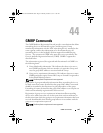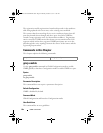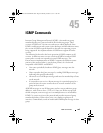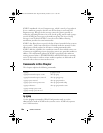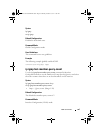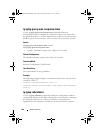
IGMP Commands 925
45
IGMP Commands
Internet Group Management Protocol (IGMP) is the multicast group
membership discovery protocol used for IPv4 multicast groups. Three
versions of IGMP exist. Versions one and two are widely deployed. Since
IGMP is used between end systems (often desktops) and the multicast router,
the version of IGMP required depends on the end-user operating system
being supported. Any implementation of IGMP must support all earlier
versions.
The following list describes the basic operation of IGMP, common to all
versions. A multicast router can act as both an IGMP host and an IGMP
router and as a result can respond to its own IGMP messages. The
PowerConnect implementation of IGMPv3 supports the multicast router
portion of the protocol (that is, not the host portion). It is backward
compatible with IGMPv1 and IGMPv2.
• One router periodically broadcasts IGMP Query messages onto the
network.
• Hosts respond to the Query messages by sending IGMP Report messages
indicating their group memberships.
• All routers receive the Report messages and note the memberships of hosts
on the network.
• If a router does not receive a Report message for a particular group for a
period of time, the router assumes there are no more members of the
group on the network.
All IGMP messages are raw IP data grams and are sent to multicast group
addresses, with a time to leave (TTL) of 1. Since raw IP does not provide
reliable transport, some messages are sent multiple times to aid reliability.
IGMPv3 is a major revision of the protocol and provides improved group
membership latency. When a host joins a new multicast group on an
interface, it immediately sends an unsolicited IGMP Report message for that
group.
2CSPC4.XCT-SWUM2XX1.book Page 925 Monday, October 3, 2011 11:05 AM







